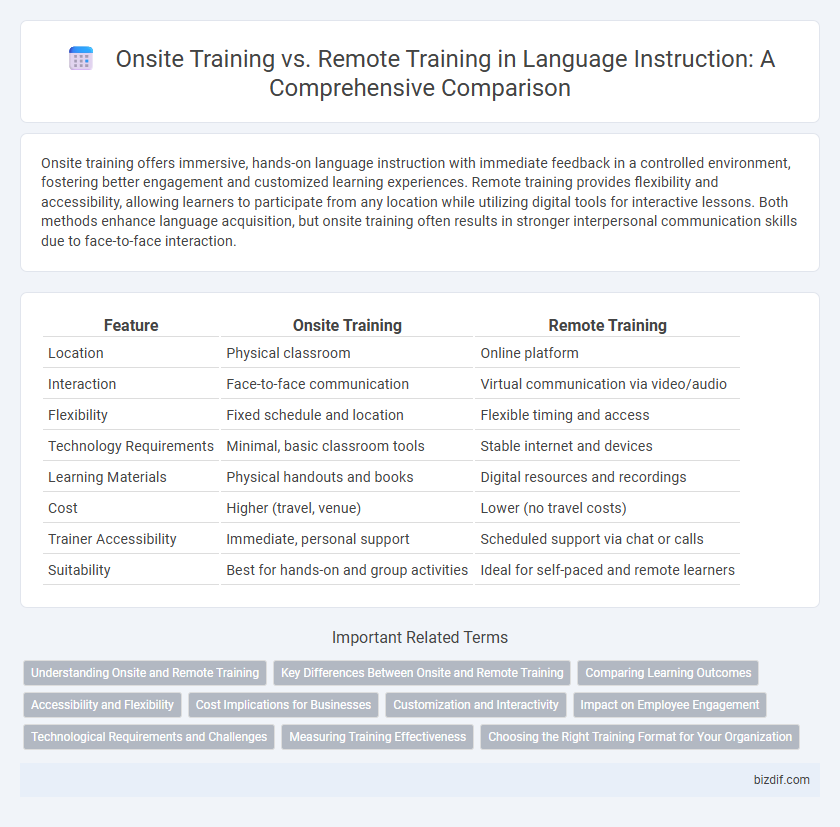Onsite training offers immersive, hands-on language instruction with immediate feedback in a controlled environment, fostering better engagement and customized learning experiences. Remote training provides flexibility and accessibility, allowing learners to participate from any location while utilizing digital tools for interactive lessons. Both methods enhance language acquisition, but onsite training often results in stronger interpersonal communication skills due to face-to-face interaction.
Table of Comparison
| Feature | Onsite Training | Remote Training |
|---|---|---|
| Location | Physical classroom | Online platform |
| Interaction | Face-to-face communication | Virtual communication via video/audio |
| Flexibility | Fixed schedule and location | Flexible timing and access |
| Technology Requirements | Minimal, basic classroom tools | Stable internet and devices |
| Learning Materials | Physical handouts and books | Digital resources and recordings |
| Cost | Higher (travel, venue) | Lower (no travel costs) |
| Trainer Accessibility | Immediate, personal support | Scheduled support via chat or calls |
| Suitability | Best for hands-on and group activities | Ideal for self-paced and remote learners |
Understanding Onsite and Remote Training
Onsite training involves face-to-face instruction within a physical location, allowing direct interaction and immediate feedback, which enhances hands-on learning and team collaboration. Remote training uses digital platforms to deliver education, offering flexibility and accessibility for learners to study from any location while relying on video calls, online resources, and digital assessments. Understanding these methods helps organizations select effective language instruction tailored to learners' needs, balancing engagement and convenience.
Key Differences Between Onsite and Remote Training
Onsite training offers direct interaction and hands-on practice, enhancing immediate feedback and team bonding, while remote training relies heavily on digital tools and asynchronous communication to maintain engagement. Onsite sessions require physical presence, facilitating real-time collaboration, whereas remote training provides flexibility and accessibility, allowing learners to participate from any location. The choice between onsite and remote training impacts logistics, learner engagement, and resource allocation, making it essential to assess organizational needs and training objectives.
Comparing Learning Outcomes
Onsite training provides immersive, hands-on experiences that enhance engagement and practical skill acquisition, leading to higher retention rates. Remote training offers flexibility and access to diverse digital resources, which supports self-paced learning but may result in lower interaction and immediate feedback. Studies indicate onsite training often yields better learning outcomes in skill-based disciplines, while remote training suits theoretical knowledge acquisition effectively.
Accessibility and Flexibility
Onsite training provides direct interaction and immediate feedback but is limited by location and fixed schedules, impacting accessibility for remote or busy learners. Remote training offers greater flexibility, allowing learners to access materials anytime and from any location, which enhances participation and accommodates diverse learning paces. Organizations seeking scalable and inclusive language instruction often prefer remote training to overcome geographical and time constraints.
Cost Implications for Businesses
Onsite training typically incurs higher costs due to expenses related to travel, accommodation, and venue rental, which can strain business budgets. Remote training reduces these overheads, offering cost-effective scalability and flexibility without sacrificing training quality. Investing in virtual platforms also minimizes downtime, allowing businesses to maximize productivity while controlling expenses.
Customization and Interactivity
Onsite training offers highly customizable learning experiences tailored to specific organizational needs, enabling real-time adjustments and personalized feedback. Remote training leverages interactive digital tools such as live polls, breakout rooms, and instant messaging to foster engagement and facilitate dynamic participation. Both modalities prioritize interactivity, but onsite sessions provide tactile, face-to-face interaction while remote training maximizes accessibility and flexible customization through technological platforms.
Impact on Employee Engagement
Onsite training fosters higher employee engagement through direct interaction, immediate feedback, and hands-on collaboration, creating a dynamic learning environment. Remote training often results in varied engagement levels due to distractions and limited real-time interaction, impacting motivation and participation. Companies integrating hybrid models optimize engagement by combining the advantages of face-to-face and virtual learning experiences.
Technological Requirements and Challenges
Onsite training demands robust hardware infrastructure, reliable internet connectivity, and dedicated physical space, which can lead to higher setup costs but ensures direct interaction and immediate technical support. Remote training relies heavily on stable broadband connections, compatible devices, and user-friendly platforms like Zoom or Microsoft Teams, facing challenges such as latency, bandwidth limitations, and potential software compatibility issues. Both modes require cybersecurity measures and IT support to prevent disruptions and maintain data privacy during instructional sessions.
Measuring Training Effectiveness
Measuring training effectiveness in onsite training benefits from direct observation and instant feedback, allowing trainers to assess participant engagement and comprehension immediately. Remote training effectiveness relies heavily on digital analytics, such as attendance tracking, assessment scores, and interaction metrics, to evaluate learner progress. Both methods utilize surveys and performance metrics, but onsite training offers richer opportunities for real-time adjustments and personalized support.
Choosing the Right Training Format for Your Organization
Selecting the appropriate training format, onsite or remote, depends on organizational goals, employee learning preferences, and budget constraints. Onsite training offers interactive, hands-on experiences and stronger team cohesion, while remote training provides greater flexibility and accessibility for distributed teams. Analyzing specific workforce needs and technological capabilities ensures an effective, scalable language instruction program.
Onsite Training vs Remote Training Infographic

 bizdif.com
bizdif.com